 Sámegillii
Sámegillii  På norsk
På norsk
Articles about Sami school history
In this web site some of the articles of the first book are also published in English. It would be too much to translate it all, so to make this history available to a greater public, we are translating a series of newspaper articles, which sorted by topics make a summary of stories in the books. So far there are 28 articles published in Sami language by the Sami newspapers Min Áigi and Ávvir. They are also published here in Norwegian and the English version will be published gradually as they are translated.
These articles are edited by the main editor, Svein Lund. Besides him the editing board of the book series consist of Elfrid Boine, Siri Broch Johansen and Siv Rasmussen.
Part 28 - printed in Ávvir 18.02.2012
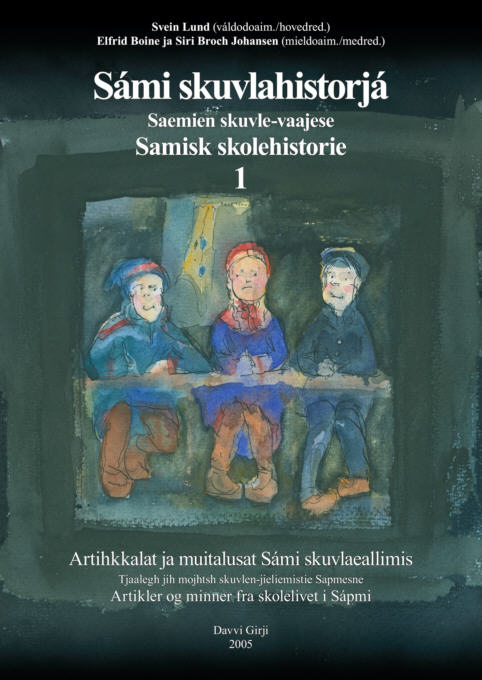
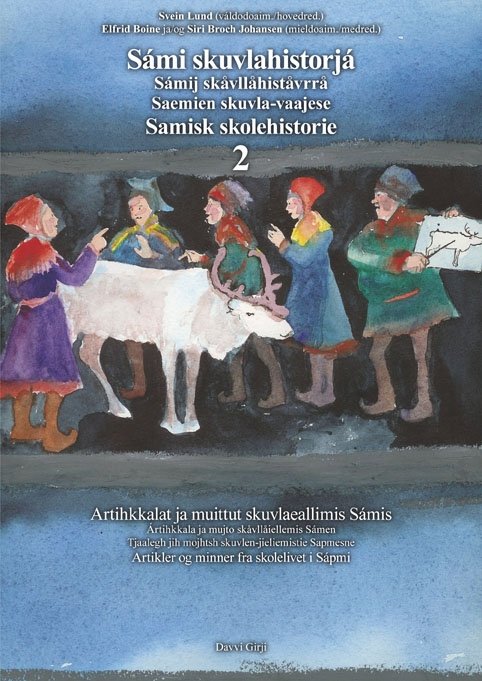
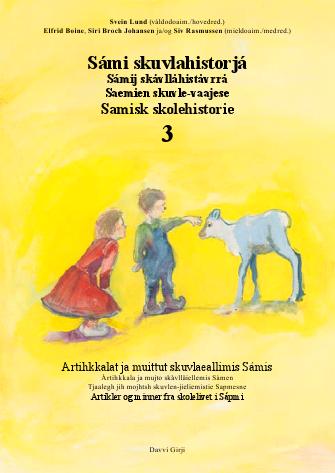
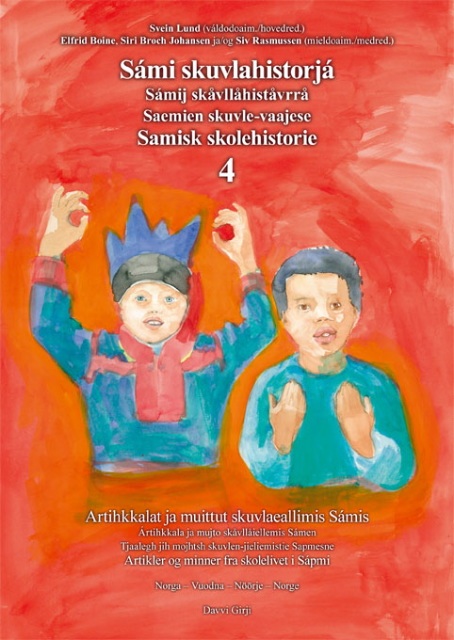
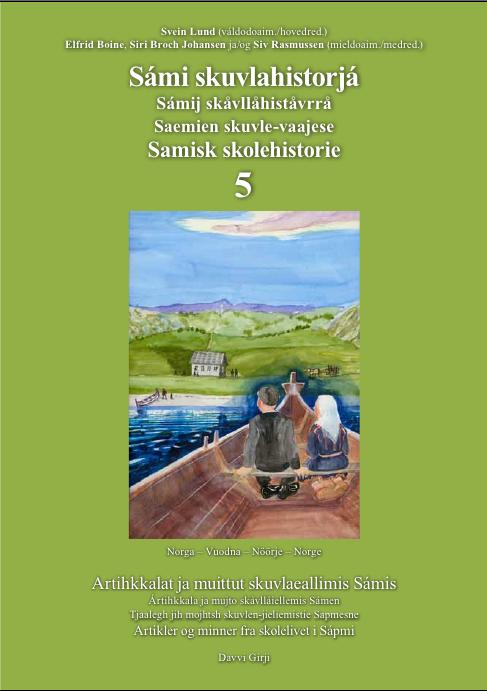
Do you know Sami school history?
Sámi skuvlahistorjá / Samisk skolehistorie (Sami School History) is a series of books published by the publishing house Davvi Girji. In about 200 articles in 5 volumes there is told about the experiences of Sami children in Norwegian schools, and about the changes in the educational politics of the Norwegian authorities towards the Sami population. The books are published with parallell text in Sami and Norwegian language. The great struggle of the curriculum
English translation by Ane Helga Lykka
Questions about Sami education have hardly ever lead to such a great interest in the media as the struggle concerning the Sami curriculum in 1997. In reality there were two different struggles, at firstwether there should be a separate Sami curriculum or not, and secondly where this should be used. It was the latter that made it to the media, the first one was less publicly known, but not less important.
Asta Balto, who worked for the Sami educational council, tells:
We did not get to work in peace for a long time before the minister of education Gudmund Hernes started his work for reform. ... The idea of the ministry was that there should be only one curriculum for everybody, and that some Sami topics would then be fitted into the national curriculum. The Ministry of church, education and research wrote in a letter dated 14.01.1994 that the ministry had promoted: «the thought that the new basic curriculum should be a national curriculum which comprises all education of the primary school pupils in the country, including the Sami central area.» The argument concerning Sami pupils was that «it is important that all pupils in the Norwegian school acquires a better and broader knowledge of the Sami people's culture and history.» In other words the Ministry used the Norwegian pupils' need to learn about the Sami as an argument opposing the separate Sami curriculum!
We could of course not accept this. Just a few years earlier we had obtained Sami curriculums in some subjects, we could by no means accept that the Sami content in Sami schools were to be weakened when the legal position of the Sami was stronger than ever. The Sami educational council replied already 04.02.1994: «The Sami educational council does not agree that there should be one common national curriculum. A separate curriculum has to be made for the areas which are included by the language rules of the Sami law. In addition to curriculums for all subjects it should also contain a general part.» ...
They still held the old understanding that equality means similarity, namely that everyone should be treated as the same; as Norwegians. ... To make Sami content a part of the work with the reform was hard and difficult work and one can not praise minister Hernes' interest in Sami questions.(SSH2)
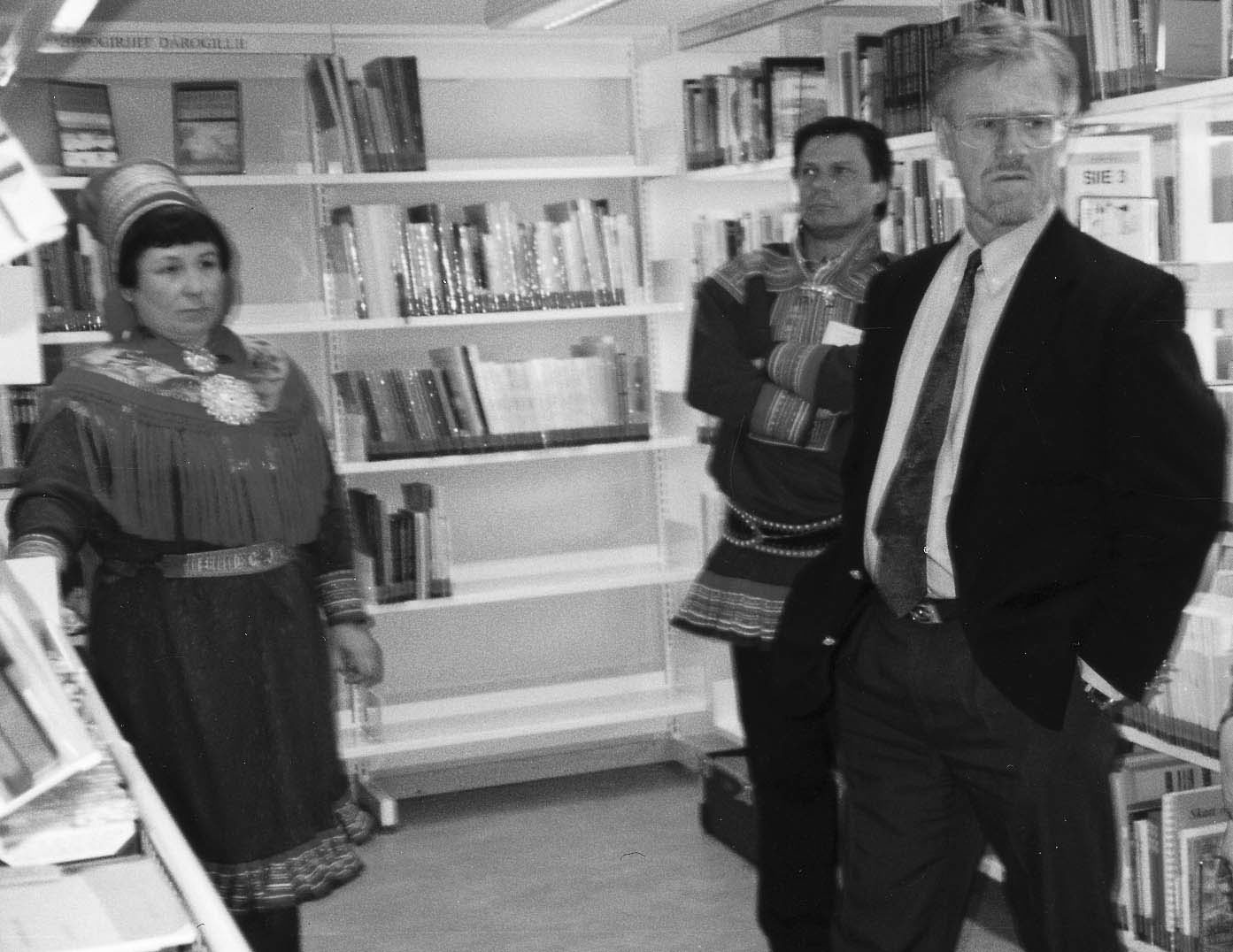 |
Once during his time as minister Gudmund Hernes visited the Sami educational council. Here he is in a guided tour in the Educational council's teaching aid exhibition with Kristine Nystad and Ole Henrik Magga. (Photo: Sami educational council 20 years) |
When we started the work with the new curriculums for the primary school, Gudmund Hernes was firm in his view that there should be one common curriculum for all pupils in the primary school, also the Sami pupils. It was not easy for a bureaucrat to oppose that. But since the Sami had their own curriculum for several subjects since 1987, they also did not accept this immediately, in particular the Sami Parliament protested. Ole Henrik Magga, the president of the Sami Parliament at the time, came to the ministry to discuss the matters with the minister and present his view. I was present in this meeting. It was not a good meeting. Gudmund Hernes was hardly prepared to listen to the view of the president of the Sami Parliament. I spoke to Magga about this afterwards. I had difficulties in understanding how two so competent men could go for each other's throats in that way. Hernes was probably a little arrogant in this meeting, it should be allowed to say, but as we were working with these questions, I suppose he also saw some different sides of the matter.
We had many discussions in the ministry, we were concerned with ensuring the same foundation of knowledge for Sami pupils as others had, to ensure that they would not have a poorer position than the Norwegian pupils in being accepted in upper secondary education, colleges and universities. With time I realized that this was possible to combine with a separate Sami curriculum for Sami pupils, which was based on Sami language and culture, but which aslo attended to important parts of the curriculum we developed for the other pupils in the primary school. (SSH5)
But then a change of minister took place in the Ministry of church, education and research. Reidar Sandal entered in December 1995. Already in the first meeting he demonstrated a completely different attitude than the former minister. Sandal simply apologized for what had happened. And quite soon it was clear that he would give in to the Sami Parliament and make a separate Sami curriculum. ... He also stated clearly that the Sami Parliament should be included actively in evaluating the curriculums before they were completed. This created a completely new situation. For my part I have never forgotten the honesty, openness and good will Sandal demonstrated. ...
I was involved in formulating the text in Sami for the part of the curriculum which was called Principals and guidelines for primary school education for the Sami curriculum, which was a link between the general curriculum and the curriculums for the single subjects. We did that work with great joy and enthusiasm. Finally we felt that our efforts were joined in useful work instead of spending them for useless struggles about issues that should have been settled a long time ago due to the changes that had already taken place in the 1980's and 1990's. Time had become very scarce, and many had to sacrifice both sleep and family life for the work. In my opinion what was worst was that Sami experts, politicians of the Sami Parliament and the political leaders of Sami educational council had to suffer because they had been been trampled on by people who did not have one jot or tittle of fundament to judge the contents of Sami school. Their arguments were only based on political power - not knowledge. (SSH5)
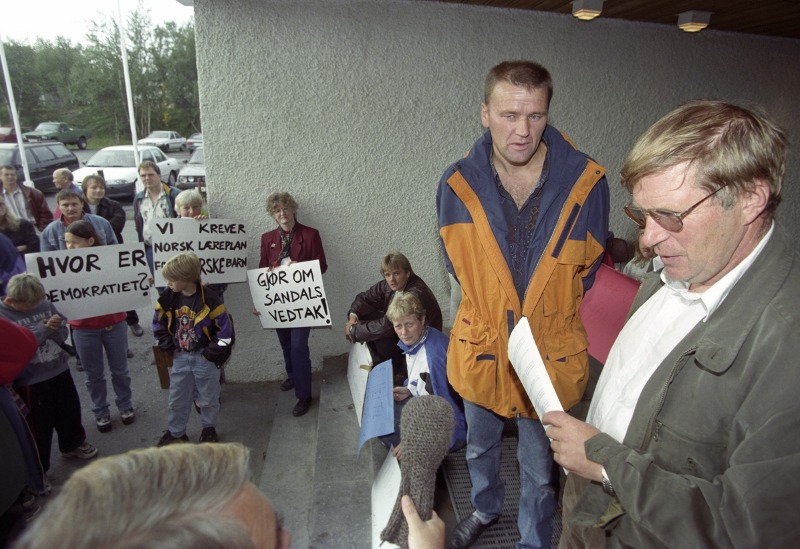 |
Demonstration protesting the introduction of the Sami curriculum in front of Tana town hall, 25.08.1997. Nr. 2 from the right is the leader of «No to Samiland», Jan Olsen. To the right mayor Leif Sundelin, who is being interviewed on the view of the municipality. (Photo: Ole Magnus Rapp, Aftenposten/Scanpix) |
Siri Broch Johansen writes about the struggle which formed in Tana:
The clearly stated goal of the first version of the curriculum was to educate new generations of Sami. From the beginning on it was not decided where the curriculum was to be applied.
After a long democratic process concerning the question of the choice of curriculum in Tana, where each school had chosen which curriculum it was natural to follow, the ministry wrote a document the 2nd of June stating that all the municipalities within the language management area were to follow the Sami curriculum. The timing could not have been worse. In Finnmarken 17th of June Grete Erlandsen, mother of three, tells how the parents at Seida school felt the decision of the ministry: «– We felt completely ridiculed. We had held several meetings and lead thorough discussions, and votedboth among pupils and parents. ... The ministry should have spoken up about their view straight away.» ...
The ministry had lead a disorderly process with the municipalities, and the language formulations in the text of the curriculum revealed an interior-Finnmark-perspective on Sami school. The curriculum did not exist in it's complete form before it was decided that all schools should follow it. The teachers left for summer vacations without having seen the complete steering document for the following school year. The resolution of the government that L97S was to be followed in the entire Sami language management area was not ready until the 16th of July. The printed version of the new curriculum was not ready before mid-August 1997....
When the school started in August 1997 there were demonstrations in front of the town hall in Tana. At the same time parents of children from three primary schools in Tana kept the children at home due to their displeasure with the new curriculum. At the time there were five primary schools in Tana: Seida, Austertana, Boftsa, Sirma and Buolbmát sámeskuvla It was children from the three first-mentioned schools, the ones which were situated in former Tana municipality, who were held home from school. – We are not Sami and do not accept that a Sami identity will be forced upon our children, Jan Olsen from «No to Samiland» said to about 50 parents and children who were present. ...
One did not agree on what the new curriculum was, or could turn into. And the curriculum opened for five different choices of language. ... Despite of all these choices, which also meant that one could choose not to use Sami completely, the principle part of the curriculum stated that the aim of the curriculum was to «...ensure a positiv development of identity and a functional bilingualism.» This illustrates that the plan had not been thoroughly worked through. The part concerning the bilingualism was removed from the final version of the curriculum.
While the parents kept their children home from school, thoughts about founding private schools started to be formed, and in addition a campaign opposing the campaign was started. In September there were two petitions in circulation in lower Tana. One from the «Parent's campaign for a national curriculum». The other petition, which was a reaction to the previous one, was a letter entitled «In favor of Sami curriculum». The parents from Boftsa, Austertana and Seida schools who wished for a Sami curriculum had written the letter. ...
The struggle was not irrevocably settled until June 1998, when the majority of the Storting passed that the revised L97S should be used in all public schools within the Sami language management area. In the first version of L97S it was stated: «To grow up means to grow into the Sami and with time the Norwegian common culture». In the final version this was changed to: «For Sami pupils it means to grow into the Sami and with time the Norwegian common culture». The formulation that the curriculum should give the pupils a Sami identity was also changed.
Small, but important changes. After loud protests and more consultative rounds the adjustments which were needed to make the curriculum acceptable for most of the inhabitants in the Sami municipalities were made. (SSH5)
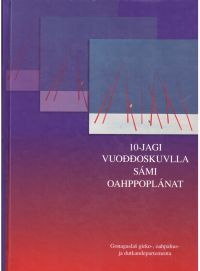 |
The apple of discord: The Sami curriculum for the ten-year primary school. |
The following year the new educational law was introduced, stating that: «The ministry makes regulations concerning other special curriculums for the primary school education in the Sami areas...» And with this it was concluded in the form of law both that there should be special Sami curriculums, and that these should be applied in the Sami language management area. Consequently there was no equivalent struggle with the following reform of curriculum in 2006.
Here you find all the articles in the series:
28.09.2007 Why Sami school history?
05.10.2007 Boundless ignorance
12.10.2007 Southerner-teachers encounter the Sami language
19.10.2007 The start of Sami beginner instruction
26.10.2007 The start of education in reindeer-herding
02.11.2007 From Sami to Norwegian vocational training
16.11.2007 Struggle for Sami gymnasium
28.11.2007 School experiences of Norwegian speaking Samis
14.12.2007 Resistence against Sami language and culture
25.01.2008 A strange world
23.05.2009 On Sami teachers
30.05.2009 Life in boarding school
06.06.2009 Sami pupils were bullied
13.06.2009 Sami content in the teaching
20.06.2009 Pupil as interpreter
04.07.2009 How the children quit speaking Sami
10.09.2010 God does not understand Sami
08.10.2010 The point of view of the Norwegianizers
13.10.2010 Men of the church defending the Sami language
02.12.2010 Sami teachers in old times
09.12.2010 Boarding school life in old times
18.12.2010 Sami pupils in special schools
14.01.2012 The parents' struggle for Sami education
21.01.2012 Reluctance and absence
28.01.2012 The school during the war
04.02.2012 Reconstruction and barrack schools
11.02.2012 Curriculums - for Norwegianization and for Sami school
18.02.2012 The great struggle of the curriculum
Sami school history 1
Sami school history 2
Sami school history 3
Sami school history 4
Sami school history 5
Sami school history - main page